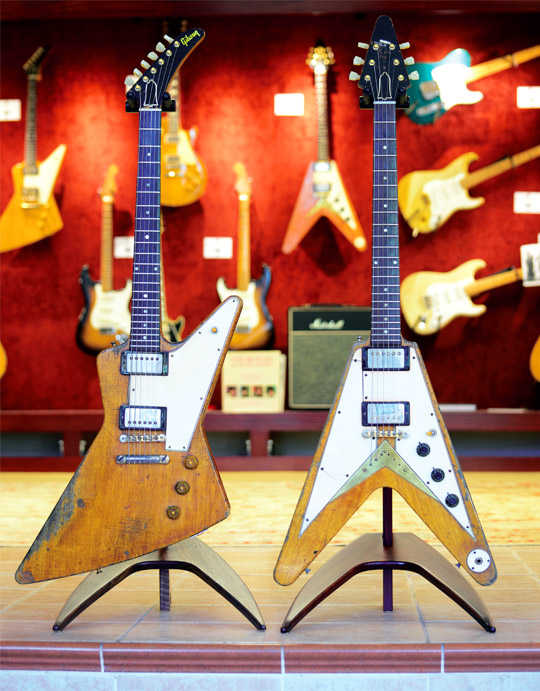
A few pounds of mahogany, maple and rosewood; some metal and plastic bits; a handful of simple electronic parts; a couple of ounces of nitrocellulose finish; several feet of steel wire. There are quite a few gizmos a clever, capable craftsman could bring to life with these basic materials. In the late 1950s, two groups of particularly accomplished artisans—one at Fender Musical Instruments in Fullerton, California; the other at the Gibson Company in Kalamazoo, Michigan—handcrafted those components into the sensual, lusted-after objects of many a young man’s fancy, then and now: Electric guitars.
That’s where Rumble Seat Music comes in. Founded in Ithaca, New York in 1993 by veteran musician and guitar collector Eliot Michael, that shop— and a sister store in Albuquerque, New Mexico—is one of the world’s premier dealers in collectible guitars. In partnership with noted Carmel resident, film composer and avid guitar collector Mark Mancina, Michael opened the doors of his Carmel-by-the-Sea shop. “I had been doing some trading through Rumble Seat,” Mancina says. “I didn’t know Eliot personally, but we’d spoken on the phone a few times.”
There’s a brisk trade among collectors for guitars built in those years. Even in today’s slightly depressed market, certain Gibson Les Paul model guitars regularly change hands for more than one thousand times their original cost—a 1959 Gibson price sheet lists the instrument at $295 plus case— and sometimes much, much more.
As with any collectible in this price range, counterfeits abound. It takes a sharp eye, honed over years of examining instruments to spot the subtle nuances that separate the authentic from the ersatz. So, naturally, in this business, trust and relationships are everything.
“Everything about Eliot is honest and above-board,” Mancina says. “And he has a natural sense for dealing with guitars.” That sentiment is echoed by virtuoso blues-rock guitarist Joe Bonamassa. “The trust factor is huge. There are forgeries and fakes out there. I’ve known Eliot as long as I’ve been collecting; he was responsible for my first collectibles. He’s a straight shooter.” So why do these planks of wood come with such high price tags? “Craftsmanship,” Michael states simply. “These instruments were built with a different mentality than exists today. Those ar tisans believed that what they were making should last a lifetime.”
Case in point: the Holy Grail of the electric guitar collecting world is the 1959 Gibson Les Paul in the “sunburst” finish. These instruments, named after a wildly popular entertainer of the day, were lovingly handcrafted in that Kalamazoo factory by master luthiers. They used only the finest materials—aged wood from the company’s vast storehouse of planks—and the expertise gained over Gibson’s decades of guitar-building excellence. It’s a gorgeous looking thing, its physical beauty only surpassed by the tones it produces at the hands of the Guitar Gods who play them: Jimmy Page, Jeff Beck, Eric Clapton, Joe Walsh, Duane Allman…and Joe Bonamassa. “In 1958 Gibson had revitalized the line by adding sunburst and using highly figured woods,” he says. “The ’59 was a perfect storm of materials and build quality.”
Also, “Gibson made some tweaks to the design that year, such as wider frets and a different color in the sunburst finish,” Michael says. It’s minutiae like that that can make the difference in thousands of dollars—sometimes scores of thousands—on a price tag.
“About 1,800 ’59s were made,” says Michael. “Perhaps 900 to 1,000 survive.” Some were broken (Michael’s first one was destroyed by a cymbal flung by The Ramone’s drummer; The Who’s Pete Townshend is probably responsible for the demise of one or two), some were lost. Carmel’s Rumble Seat Music isn’t about guitars on display behind glass, however. When all is said and done, these are still musical instruments, meant to be played. Can you walk in and actually belt out the solo from “Stairway to Heaven” on that ’59 Paul on the wall? Sure. “We want to make the experience of coming into this shop to be like going to a museum where you can play with the displays,” Mancina says. “We’re aiming for an unhurried, gallery-like feel here,” Michael adds. “For instance, we have Eric Clapton’s Gibson Explorer hanging on the wall in the Carmel shop. One guy was looking at it with awe. I said ‘go ahead, play it,’ but he was hesitant. I pulled it down and handed it to him. It’s a guitar. That’s what it’s for.”
Another Carmel resident, Barry Manilow guitarist Michael Lent, paid a visit to Rumble Seat recently. “The first word out of my mouth was ‘Wow!’ That back wall is a rare and impressive sight…an awesome collection of some of the most valuable guitars in the world.” He played a somewhat pricey instrument. “That was the only time in my life I’ve played a $400,000 guitar,” Lent laughs. “I was pretty nervous hanging it back up on the wall.” Inventory isn’t limited to uber-high end collectible electric guitars; there are guitars in stock suitable to everyone from the weekend warrior to the working pro. “Our typical customer is a player who is taking the next step up,” Michael says. Aside from Gibson and Fender, other manufacturers represented include Ribbecke, Paul Reed Smith, Rickenbacker and Taylor.
Ostensibly, Carmel-by-the-Sea may seem an odd choice for a guitar shop of this caliber. But these gems of the musical world truly are works of art, worthy of inclusion in any art museum. From that perspective, Rumble Seat is right at home among the many galleries and jewelry stores that line the surrounding streets…with a difference. These are pieces of art you can dance to.
Rumble Seat Music is located on Dolores between 7th and 8th Avenues. Visitwww.rumbleseatmusiccbs.com. 831/293-8299.